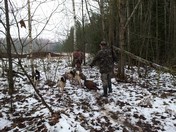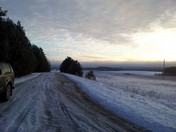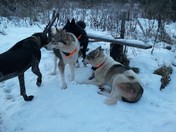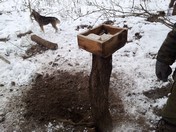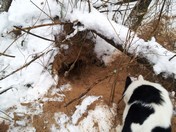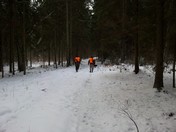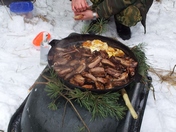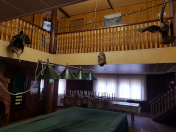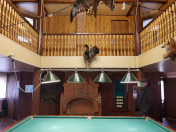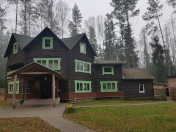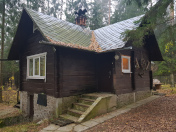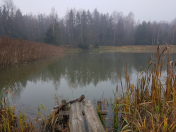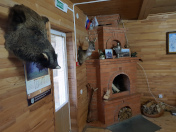Elk Hunting in Belarus
We are offering a great opportunity to go elk hunting in Belarus. Our hunting grounds have preserved unique hunting traditions. Many years of experience in gamekeeping and hunting, the best hunting grounds in the CIS, trophy animals - all this is hunting in Belarus.
Elk Hunting with a Hound
One of the primary breeds for elk hunting is the husky. These dogs are considered to be universal for hunting. A specially trained dog is able to follow the trail of the beast very closely, without scaring it away, leading the hunter to a convenient position. The dog should not be aggressive. Aggressiveness may scare the beast away, which will run very far away, and it will not be possible to catch it. The husky follows the trail quietly, without making unnecessary sounds, and only having come very closely, it should bark.
Elks are very suspicious and shy, react to any rustle and movement. A joint hunt of a hunter and a dog should be coordinated and worked out in detail. When an elk is detected, the dog should not rush to the animal; it should only bark at the animal and run around, confusing the beast. The dog needs to be extremely cautious not only in tracking the elk, but also in pursuing. Elks can be aggressive and can kick a hostile husky with their hooves. Unfortunately, for the dog, who comes under the elk’s attack, this encounter will be the last.
The most experienced and trained hounds, they are called "elk hunters", can drive the elk under the shot.
However, you should not rely only on the dog, the hunter also needs to be in excellent physical shape, since they have to run several kilometers at a very fast pace.
Do not forget that other hunters are as dangerous as the elk. It is necessary to carefully study the trajectory of the shot to prevent crossfire.
Hunting with Vaba (with calling)
The hunt with vaba (a decoy for calling) is conducted during the rut. At this time, the elk makes its call-up sounds. And it is during this exact period that elks have their posh horns, since at other times, they lose their horns in fights with rivals. The places where the rut takes place are called the rut pits.
In order to determine the rut pits, you need to pay attention to the areas, where there are creases and scratches on the trees.
"Vaba" is a decoy for the elk, which imitates the sound of a male, which should be heard at long distances, therefore, a megaphone might be used additionally.
An elk calling decoy is easy to buy, but many avid hunters prefer to make them themselves, or use their palms to imitate the roar of an elk. When using the call for the elk, you should not blow into it too often since the elk should have a desire to fight its opponent. The rutting elk practically does not control the situation around itself to a sufficient extent to guarantee its safety, therefore this is the most suitable period to get close to it at the distance of a shot.
The elk hunt with "vaba" requires the hunter to use it skillfully and correctly, as the success of hunting depends on this.
Driven elk hunt
This type of hunting requires a team of six to eight people, as in this case it is much easier to distribute responsibilities among them.
In the morning, two hunters go to survey the area and carefully study elk tracks. If there are many traces, you can start the hunt. The group of hunters is distributed according to their numbers, which they initially set among themselves, at a distance of 40-50 meters from each other, so that the wind would blow on them from the beast. Another group (beaters) run across the driving area and make noises, driving the elk out of the forest. This group of hunters should not miss a single spot where the beast can hide. In this hunt, dogs are also involved, barking to indicate the direction in which the beast is going.
At first, the elk goes at a quiet pace, then starts to accelerate it. When it gets profoundly scared, the beast begins to run through obstacles, breaking the bushes on its way. After taking the elk, the reward (head and entrails) is received by the hunter, who stopped the beast with the first shot. If the beast escapes, the driving starts anew.
Walk & Stalk hunting (from the hiding)
This type of hunting can be carried out by a single hunter. This hunt takes place in the winter. By the elk trail, the density of the walls of the tracks is determined. The straight shape with the snow thrown out of it suggests that the animal had been driven by beaters.
Unhurried. A little trampling on the snow by the beast. Such a trace is a signal to the start of the chase. The hunter should begin to gradually approach the beast. You can climb a tree and inspect the area to spot a more accurate location of the animal. The main thing to know is that the elk will not allow a person to approach closer than 70 meters.
Online tour application
If you would like to go elk hunting, please, leave an application and we will contact you.
Cost for hunting and services in EUR, elk
| Horns with the skull without the lower jaw, weight (kg) | |
| Up to 4,99 | 700 |
| From 5,0 to 5,99 | 800 for 5,00 kg + 3,0 EUR for every 10 g |
| From 6,0 to 6,99 | 1100 for 6,0 kg + 4,0 EUR for every 10 g |
| From 7,0 to 7,99 | 1500 for 7,0 kg + 4,0 EUR for every 10 g |
| From 8,0 to 8,99 | 1900 for 8,0 kg + 4,5 EUR for every 10 g |
| From 9,0 to 9,99 | 2350 for 9,0 kg + 4,5 EUR for every 10 g |
| From 10,0 and more | 2800 for 10 kg + 5,0 EUR for every 10 g |
| Shooting a grown-up non-trophy male | 700 |
| Shooting a female | 800 |
| Shooting a (under) yearling | 350 |
| Wounding a grown-up trophy male | 350 |
| Wounding a non-trophy male | 1000 |
| Wounding a female | 400 |
| Wounding a (under) yearling | 175 |

